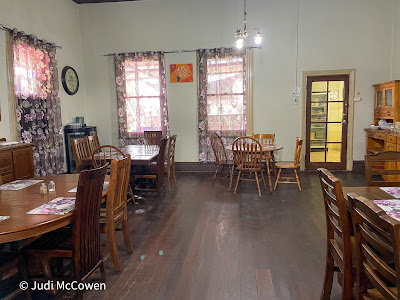Kalgoorlie-Boulder is a mining town. It is not the prettiest town we have driven into in our 118 days on the road but then again it doesn't need to be pretty. Leave that to the coastal villages. The caravan park is also not the best we have stayed in. At a guess I would say that it is 80% permanent with mostly mine workers. We found our site only after having to ring the after hours phone number. On the map that was left for us in the night safe it was marked as site 18 but in reality it is actually site 12. That is very confusing. The site has units right behind it and to the right there is another unit in the shape of an airport hangar - I kid you not. If I didn't know already that I have the best husband in the world, I know now, as he put his arm around my shoulder and said "It's Ok. I'll make it homely" and he did. I love this man.
Anyway enough of the negatives, let's focus on the positives. It is a town with a population of around 30,000 residents, about the same size as Mount Isa. There are two shopping precincts, one in Boulder and the other in Kalgoorlie. We are at Boulder. As we drive into town the "Super Pit" is on our left hand side. We are booked on a tour of the Super Pit on Thursday - the earliest day we could get - but we just could not miss it. I have been looking at what we should see and do in the area and the Tram Ride is apparently pretty good as it stops at most of the older parts of Kalgoorlie and you can alight at these places.
We have been told to avoid the underground mine tours as they can be a little daunting. I wouldn't do an underground in any case. It would freak me out! The visitor information centre was closed as we entered Kalgoorlie-Boulder so it will be the first place we visit tomorrow. All tours are booked through this centre and we will do as many as we can as we are here for five nights.
So what did we see on our 230km journey today from Leonora to Kalgoorlie-Boulder? It was almost a repeat of our journey yesterday for the first part of our drive. One thing we have noted driving throughout Western Australia is the quality of the roads. They are far superior to any other state in Australia and well maintained. Admittedly it has a lot to do with the road base and most of Western Australia has the perfect base with its red stony ground that covers the majority of the state. The roads are some of the straightest we have ever seen and I thought Western Queensland won that competition!
We stopped at Menzies for our Brunch break and were impressed with the tiny little town. There were many caravans pulled up outside the one and only shop cum cafe that apparently makes very good coffee. The Main Street is lined with "street art" sculptures all depicting the towns past and well worth stopping to read the information attached to them.
 |
| This one says "What on earth made you think you could rob the Post office and get away with it" (Const Samuel Evans one of the first policemen posted to Menzies in 1895) |
Soon, we come across a sign saying "Welcome to the Great Western Woodlands" on one side of the road and the other says "Goodbye from the Northern Goldfields", and all of a sudden there is a change of scenery as large trees loom on both sides of the road. Is this the western woodlands?
As we get closer to Kalgoorlie-Boulder, there are many mine sites on both sides of the road. We pass Ora Banda (Gold), Golden Cities (Gold), Paddington (Gold) and Mt Pleasant (Gold), all within a short distance of each other. No wonder prospectors love coming to this area. Philip read that a nugget weighing 260g was found by a prospector in 2020 but that is small in comparison to the 1.4kg nugget found in 2019. It has certainly sparked a "gold rush" in the Kalgoorlie region with many grey nomad prospectors flocking to the region.
There is certainly a chill in the air as I write this blog. Last night at Leonora the temperature dipped to two degrees. It didn't worry us though as we kept the heater on all night set at 28 degrees 😁. The forecast says cold and windy weather for the time we are here with maximums reaching just 16 degrees. Brrrrrr.....































































